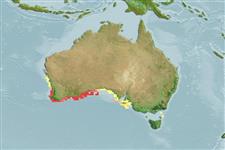>
Blenniiformes (Blennies) >
Clinidae (Clinids)
Etymology: Ophiclinops: Greek, ophis = serpent + Greek, klinein, kline = sloping and bed, due to the four apophyses of sphenoid bone + Greek, ops = appearance (Ref. 45335).
Environment: milieu / climate zone / depth range / distribution range
Ecología
marino asociado a arrecife; rango de profundidad 13 - 15 m (Ref. 33839). Temperate
Eastern Indian Ocean: southern Australia.
Tamaño / Peso / Age
Maturity: Lm ? range ? - ? cm
Max length : 9.5 cm TL macho / no sexado; (Ref. 33839)
Short description
Claves de identificación | Morfología | Morfometría
Espinas dorsales (total) : 56 - 59; Radios blandos dorsales (total) : 1; Espinas anales: 2; Radios blandos anales: 43 - 45. Remarks: pectorals tiny, length less than eye diameter.
Found in areas with seagrass, reef and weed (Ref. 33839). Minimum depth from Ref. 58018.
Life cycle and mating behavior
Maturities | Reproducción | Spawnings | Egg(s) | Fecundities | Larva
Gomon, M.F., C.J.M. Glover and R.H. Kuiter (eds.), 1994. The fishes of Australia's south coast. State Print, Adelaide. 992 p. (Ref. 33839)
IUCN Red List Status (Ref. 130435)
Threat to humans
Harmless
Human uses
Herramientas
Special reports
Download XML
Fuentes de Internet
Estimates based on models
Preferred temperature (Ref.
123201): 17.4 - 18.4, mean 18 °C (based on 46 cells).
Phylogenetic diversity index (Ref.
82804): PD
50 = 0.6250 [Uniqueness, from 0.5 = low to 2.0 = high].
Bayesian length-weight: a=0.00513 (0.00223 - 0.01182), b=3.06 (2.86 - 3.26), in cm total length, based on LWR estimates for this (Sub)family-body shape (Ref.
93245).
Nivel trófico (Ref.
69278): 3.3 ±0.4 se; based on size and trophs of closest relatives
Resiliencia (Ref.
120179): Alto, población duplicada en un tiempo mínimo inferior a 15 meses (Preliminary K or Fecundity.).
Fishing Vulnerability (Ref.
59153): Low vulnerability (10 of 100).
